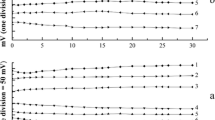Abstract
A pentachlorophenolate—a sensitive device based on an ionic associate of astraphloxine pentachlorophenol has been developed. The proposed sensor possesses satisfactory electroanalytical characteristics, which makes it possible to use it in its potentiometric determination of pentachlorophenol in water.
Similar content being viewed by others
References
Muino, MA.F. and Lazano, J.D., Ana. Chim. Acta., 1991, vol. 247, pp. 121–123.
US EPA. Pentachlorophenol Carcinogenicity Summary Table, Cincinnati, OH: AWBERG Library, 1990.
MUK 4.1.2479-09. Metody kontrolya. Khimicheskie factory opredeleniya pentakhlorfenola v pishchevykh produktakh (MUK 4.1.2479-09. Methods of Control. Chemical Factors for Determination of Pentachloropheno in Food Products), Moscow: Federal Service in the Field of Protection Consumer’s Rights and Human Welfare, 2009.
Pentachlorphenol and Its Salt and Esters: Joint TAO Junepr Programme for the Operation of Its Prior Informed Consent: Food and Agricultural Organization of the United Nations Environmental Programme, Rome; Geneva 1991, amended 1996, pp. 49–62.
Fedorov, L.A., Dioksiny kak ekolicheskaya opasnost: petrospektiva i perspektivy (Dioxins as Ecological Hazard: Retrospective and Perspectives), Moscow: Nauka, 1993.
Leblance, Y.G., Gilbert, R., and Hubert, J., Anal. Chem., 1999, vol. 71, pp. 78–85.
Meyer, A. and Kleibohmer, W., J.Cromatogr.,A., 1995, vol. 718, pp. 131–139.
Mapes, J.P., McCland, K.D, Movassaghi, S., et al., Bull. Envir. Contam. Toxicol., 1992, vol. 49, pp. 334–341.
Reigner, B.G., Rigod, J.F., and Tozer, L.N., J. Chromatography. Biomed. Appl., 1990, ee
Butter, W. and Fooken, C., Fresenius J. Anal. Chem. 1900, vol. 336, pp. 511–514.
Butter, W., ibid., vol. 326, pp. 449–452.
Gremaud, E. and Turesky, R.J., J. Agric. Food Chem., 1997, vol. 45, pp. 1229–1233.
Tayal, A., Das, L. and Kaur, I., Biomed. Chromatogr., 1999, vol. 13, pp. 220–212.
Sherma, J. and McGinnis, S.C., J. Liquid Chromatogr., 1995, vol. 18, pp. 755–761.
Perrez, M., Barrios, C., Saelzer, R., et al., J. Hight Resolut. Chromatogr., 1989, vol. 12, pp. 519–421.
Andres, M.D., Canas, B., Izquierdo, R.C., et al., J. Chromatog.,A., 1990, vol. 507, pp. 399–402.
Ying Liu, Bei Wen, and Xiao-quan Shan, Talanta, 2006, vol. 69, pp. 1254–1259.
Hanrahan, G., Patil, D.G., and Wang, J., J. Environ. Mont, 2004, vol. 6, pp. 657–664.
Lurye, Yu.Yu., Spravochnik po analiticheskoi khimii (Reference Book on Analytical Chemistry), Moscow: Khimiya, 1989.
Ishchenko, A.A. and Shapovalov, S.A., J. Appl. Spectroscopy, 2004, vol. 71, pp. 605–629.
Nakanisi, K., Infrakrasnie spektry i stroenie organicheskikh soedinenii (Infrared Spectra amd Composition of Organic Compounds), Moscow: Mir, 1965.
Bol’sshkov, G.F. and Glebovskaya, E.A., Tablitsy chastot infrakrasnykh spektrov heterotsiklicheskikh coedinenii (Tables of Frequencies of Infrared Spectra of Heterocyclic Compounds), Leningrad: Khimiya, 1968.
Nakamoto, K., Infrakrasnie spektry neorganichesikh soedineniy i koordinatsionykh soedinenii (Infrared Spectra of Inorganic Compounds and Coordination Compounds), Moscow: Mir, 1966.
Bellami, L., Infrakrasnie spektry slozhnykh molekul (Infrared Spectra of Complex Molecules), Moscow: Izd-vo Inostr. Lit., 1963.
Bellami, L., Novye dannye po IK-spektram slozhnykh molekul (New Data on IR Spectra of Complex Molecules), Moscow: Mir, 1971.
Mironov, V.A. and Yankovskii, S.A., Spektroskopiya v organicheskoi khimii (Spectroscopy in Organic Chemistry), Moscow: Khimiya
Umezawa, Y., Umezawa, K., and Sato, H., Pure Appl. Chem., 1995, vo. 67, pp. 507–618.
Author information
Authors and Affiliations
Additional information
Original Russian Text © Zh.A. Kormosh, T.I. Savchuk, Ya.R. Bazel, 2013, published in Khimiya i Tekhnologiya Vody, 2013, Vol. 35, No. 4, pp. 275–285.
About this article
Cite this article
Kormosh, Z.A., Savchuk, T.I. & Bazel, Y.R. The potentiometric sensor for determination of pentachlorophenol in water. J. Water Chem. Technol. 35, 152–158 (2013). https://doi.org/10.3103/S1063455X13040024
Published:
Issue Date:
DOI: https://doi.org/10.3103/S1063455X13040024




